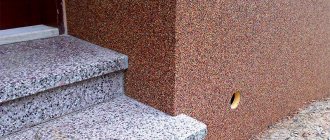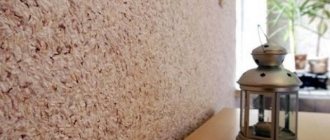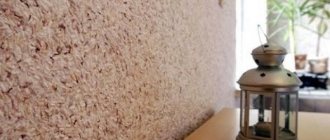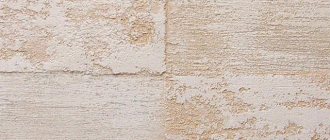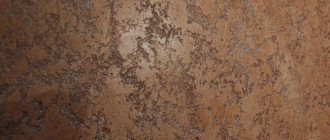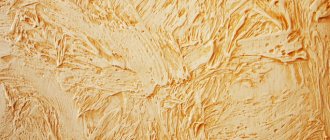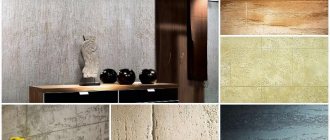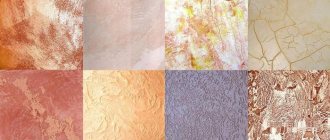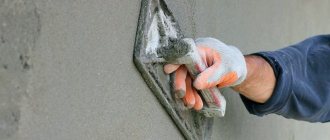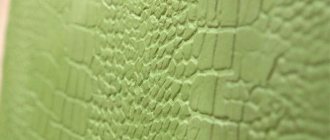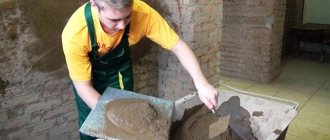Marble decorative plaster is justifiably gaining more and more popularity. It is perfect for finishing a variety of surfaces.
It is from decorative plaster with marble chips that an aesthetic, durable and durable coating is created. Few people think that it also serves as reliable protection against negative harmful effects for the surfaces on which it is applied.
The average service life of this material is 20 years. Plaster based on marble chips, applied in accordance with all the rules of the technological process, is not afraid of mold.
A fully cured layer can be washed with a stiff brush without damaging it. This mineral-type finish can elevate even the most modest interior.
Types of marble plaster
Today the following types of material are known:
- with the addition of granulated marble chips;
- with marble flour.
Based on the size of the crumbs, the following types are distinguished:
- from 0.2 to 1 mm;
- from 1 to 3 mm;
- from 3 to 5 mm.
If we take the type of binders as the basis for the classification:
- plaster;
- limestone;
- cement-sand;
- acrylic.
Readiness degree:
- in the form of a solution. You can start working almost immediately;
- dry. They will need to be diluted with water first.
They are suitable both for interior work and for finishing facades and other open-air surfaces.
More additional useful information
Decorative plaster is widely used for interior decoration. The building material allows you to create any fantasies of the owner. Granite plaster perfectly decorates both expensive and modest surfaces. The most popular final finishing option is plaster with the addition of marble.
Acrylic polymers and minerals combined with colored stone chips give an unusual look. The plaster adheres well to the surface due to the addition of special substances. Mother of pearl, wax, varnish or glitter are often used for decoration.
We hope that after reading the article, you have read and learned about granite plaster for exterior work in general, the costs of such repairs, the properties of plaster, prices and costs, and where it is better to buy.
Source
Features of the material
This type of building material may have different composition. Its features depend on the components of which it consists. The basis is marble flour or crumbs. Often, to reduce the price of this material and increase strength, manufacturers can add fine granite.
They are combined into a single mass using mineral additives or acrylic resins. It is possible to add special compounds to combat mold, fungi and pathogenic bacteria. Natural mother-of-pearl is often added for beauty.
Advantages and disadvantages
Marble plasters have many advantages:
- suitable for finishing work not only inside the house, but also for exterior finishing of facades and other surfaces;
- long useful life;
- color is not limited to the natural palette of marble;
- successfully resists mechanical stress;
- breathes;
- not afraid of moisture, temperature swings and ultraviolet radiation;
- effectively protects surfaces from mold and mildew;
- absolutely safe from an environmental point of view;
- It is comfortable to work with this type of plasters.
Flaws:
- over time, the original color saturation of the coating loses;
- may collapse upon contact with a number of chemically aggressive substances (hydrochloric acid, etc.);
- this pleasure is not cheap.
What it is
Marble and granite plaster is a type of pebble decorative mixtures in which chips of natural stone are mixed with a binder base:
Some materials may also contain additives, for example, to give the finished coating resistance to fungus formation or water-repellent properties.
This type of plaster adheres firmly to any substrate: it can be used for finishing stone, concrete, wood, brick, plasterboard surfaces, as well as walls painted with water-based paint.
Depending on the size of the crumbs, marble plaster is divided into:
The shape of the granules can be round or with sharp edges.
Decorative plaster is available in different colors, mainly natural shades. If desired, you can add color to the composition before application or paint the finished coating.
Marble plaster is intended for interior and exterior decoration . It is used for rooms with high traffic, halls, staircases, balconies and loggias, including unglazed ones. You can also use this material for external walls of buildings, plinths, columns, fences and other elements.
Advantages . The popularity of plaster with marble chips is explained by its high performance qualities. She:
Maintenance of the coating is minimal - any dirt can be removed from it using wet cleaning.
The main disadvantage of this finishing material is the high cost of finished materials.
The photo shows examples of marble facade plaster:
Photos in the interior:
Popular brands . Decorative plaster with marble chips is produced by different manufacturers. For example, completely ready-to-use formulations:
Dry plasters with granite and marble chips:
Cooking proportions
Each manufacturer himself indicates the proportions and algorithm for preparing the plaster mortar on the back of the package, often step by step. You can try to prepare it yourself, but it is better to prefer a factory-made mixture to get a guaranteed result.
Approximate consumption
Structural plasters made from marble chips are applied in a layer of 1 to 3 millimeters. It all depends on how deep the texture you want to achieve. If you plan to apply one time to a height of 1 mm, then 1 kilogram of plaster mixture will be required per 1 square meter of surface. 10 square meters of wall in the same one layer - a 25 kg bag of the mixture will be enough. If you want to apply in 2 to obtain a thicker coating, it is better to purchase two bags in advance.
Marble plaster is applied in a layer 1-3 mm thick
Composition and technical characteristics
Granite plaster (also with granite chips) has the following components:
Without these components, plaster with crumbs will not bring the required results, so the presence of components in the substance is mandatory.
Finely crushed decorative stones are added to the building material. Sometimes granite, sometimes marble, and sometimes quartz are used in plaster. Granite chips must have equal proportions. The crumbs are sifted and rolled out under a press, and then polished well. These manipulations are carried out so that the wall on which the plaster is applied is smooth.
self-leveling floor does not spread well
Technology of applying plaster with marble chips
To obtain a high-quality and durable plaster layer, the application technology involves breaking down the entire complex of work into separate stages. Experts do not advise violating their sequence and recommendations. In this case, the finish will not be durable enough to last the entire service life. Its aesthetic appearance may also suffer greatly.
Required Tools
To apply plaster to the surface selected for finishing, you will need the following tools:
- a suitable container to prepare the plaster solution;
- mixer or electric drill with a special attachment for stirring;
- ruler;
- grater made of stainless steel;
- flat brush;
- metal trowel;
- masking tape;
- cotton gloves;
- ruler;
- plumb line;
- building level;
- grout.
Can be applied with a trowel (grater)
Preparing the walls
To obtain a high-quality and reliable plaster layer, you will have to competently carry out all the necessary preliminary work:
- thoroughly remove the old coating from the walls;
- all protruding elements on the surface are dismantled;
- It is better to smooth out surface unevenness using putty;
- check the result using plumb lines and a building level;
- After the rough layer has dried, apply the primer in 2 layers with an interval of 3 to 4 hours.
If the surfaces are too uneven, we recommend that you first level them using drywall. The joints should be sealed using putty. After this, the surfaces are primed. Structural marble plaster will hide minor defects without further elimination.
Manual application
Manual plastering cannot be done efficiently without preliminary preparation of the plaster composition. The thick mixture can be easily diluted with a solvent or plain water. The proportions are indicated by the manufacturer on the outside of the container.
Step-by-step instruction:
- mix the dry plaster, adding the amount of liquid specified in the instructions. If it is not liquid enough, then dilute it until the desired consistency is obtained;
- take some mortar onto the trowel. Please note that you should hold it strictly at an angle of 60 degrees;
- the mixture should be applied to the surface to be treated only in one direction and with little force to adhere to the base;
- wait about half an hour for the layer to dry;
- if necessary, apply 2 and a third;
- as soon as the plaster layer begins to set, you need to rub it in using grout. Then you need to make circular movements with the grater tool, make sure that the pressure is the same;
- wait until the plaster is completely dry;
- take acrylic varnish, wax or other water repellent and process it.
Mechanized method of application
The manual method takes an unreasonably long time and effort. Therefore, they often resort to a mechanized version of applying marble plaster. You will need a pneumatic crumb thrower or other device suitable for its functions:
- Scoop up a solution of marble plaster into a working container and pump air into the compressor. A layer of the mixture is applied to the surface prepared for finishing. The working pressure should be stable and be 6-7 atmospheres. Sharp or jerky movements are not allowed when moving the bucket down from above.
- The distance to the surface should be 250-450 mm. It is important to control the uniformity of application of the mixture.
- After a 30-minute pause, the surface must be wiped down. You will need a metal smoother. After the surface has completely dried, it must be treated with a protective compound.
Creating a drawing
If you want to create a pattern, as in bright photos from the Internet, then take from two colors of marble plaster. You will need masking tape so as not to spoil the design, ornament, stripes or shaped insert. You need to prepare the image that you plan to transfer to the plaster layer.
Tools for creativity:
- ruler;
- scotch;
- building level;
- pencil or felt-tip pen for marking.
First, the contours of the future image are applied to the surface according to the template. The order of application of the plaster composition is noted. Apply masking tape along the contour of those you plan to start applying. Then the plaster of the desired shade is applied, it is important not to get behind the tape. Then we carefully remove it and start working on another area of the surface while the applied layer dries.
Scope of application
Marble plasters are excellent for finishing surfaces that require enhanced protection from moisture - foundations, plinths, external walls of houses, as well as saunas, swimming pools and bathrooms.
Marble plaster applied to the wall
Thanks to their convenient application, such compositions are also an ideal solution for finishing curved surfaces - columns, niches, figured ledges, bay windows. They are used for finishing openings, small architectural forms, residential and non-residential premises.
Marble plaster: finishing apartment walls
These solutions can be applied to any substrate that is not prone to shrinkage: concrete, brickwork, foam and cinder blocks, chipboard and plasterboard, plastered surfaces.
Decorating cottage walls with marble plaster
Finish coating
It is best to further protect the plaster layer after complete drying. For example, you can varnish, but only after the layer has dried for 24 hours.
You will need to first sand the surface and apply paint in order to highlight the beauty of the texture.
Then apply varnish, preferably water-based, and let it dry completely. This varnish dries quickly and spreads better over the surface of the plastered wall. The paints used are the same as for interior and facade work, taking into account the specifics of use.
Wax will also help refresh faded paints and highlight the texture. It will also protect against dust, dirt and mechanical damage.
What color does it come in?
Most often you can see the use of white marble in the interior. A light base, gray veins - this is exactly what comes to mind when you hear the word “marble”.
- The second most popular is beige. It looks more gentle in comparison with the first option, creates a warmer atmosphere. The fact is that the high temperature of the shade extinguishes the coldness of the stone.
- Black marble closes the TOP 3. The dark shade helps in creating interesting compositions: it goes well with both light stone and other textures.
Less popular, but therefore more exclusive, are color solutions. Green is associated with malachite, as well as classic-style cabinets. Brown is a warm black that goes well with beige. Blue, pink, burgundy, lilac are used to highlight accents.
DIY marble plaster
If you prefer to do everything yourself, then professionals recommend taking the following recommendations as a basis. Take:
- 1.89 liters of marble chips and dust;
- 1.89 liters – slaked lime for interiors, white decorative plaster (a set of colors included) or sand-cement mixture is suitable;
- about 30g of soap or degreaser for washing dishes;
- 350 ml – linseed oil. It acts as a plasticizer.
- 180 ml – water.
- Dye
If possible, it is better to replace them with acrylic resins. The plaster composition will be more manageable.
Knead the mixture by adding water or thinner until it becomes a thick cake batter. Add paint pigments.
Marble chips
The homemade composition is very economical when applied for the first time in 1 layer: approximately 200-300 g per 1 square meter of surface. The subsequent ones will require more plaster composition.
Photo
Tyutyunnikov Dmitry
Article verified by a decorative finishing specialist
